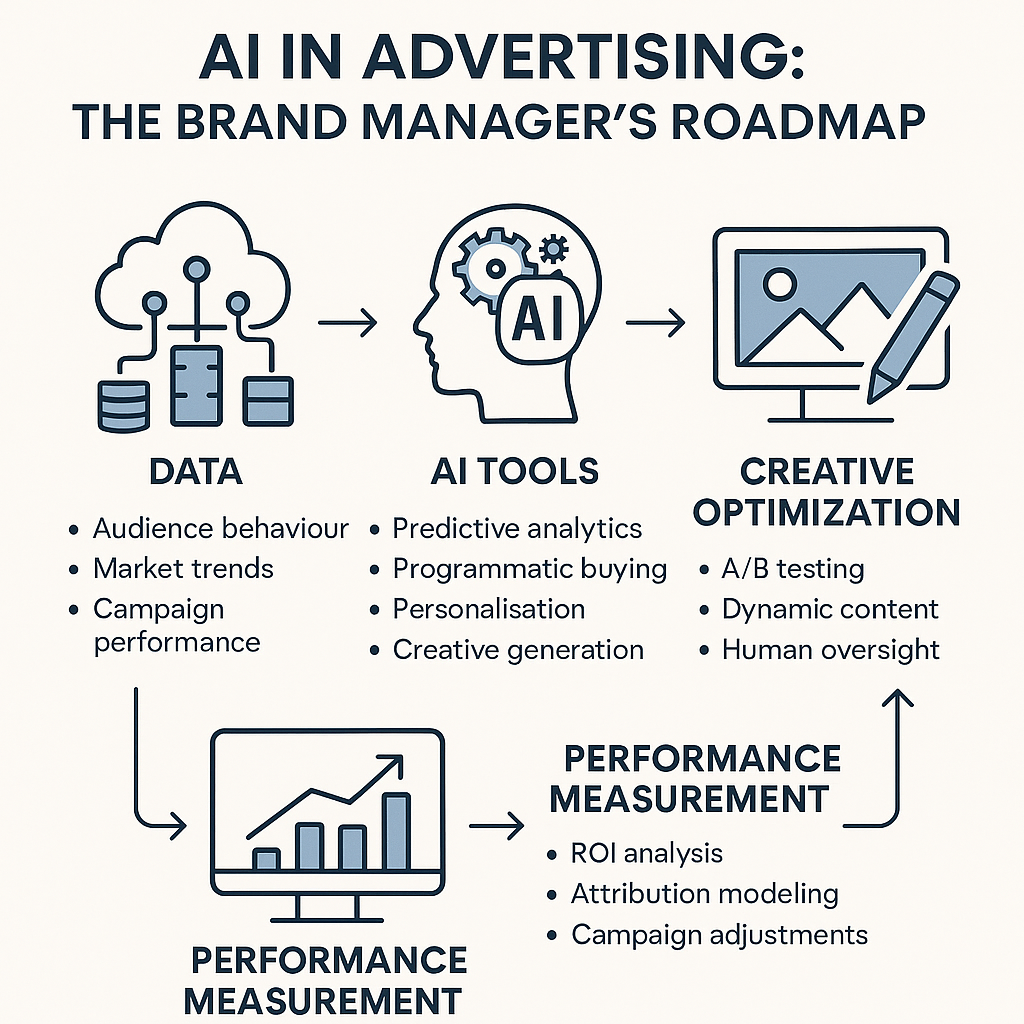The advertising landscape is changing faster than ever — and Artificial Intelligence (AI) is at the centre of that transformation.
From predicting consumer behaviour to generating ad creative in seconds, AI is no longer a futuristic concept. It’s a practical, everyday tool helping Australian brand managers make smarter, faster, and more profitable decisions.
But with so many tools, trends, and buzzwords in play, it can be difficult to know where to start.
This guide breaks down how to use AI effectively in advertising — from creative generation to media optimisation, and how to balance automation with the human insight that keeps campaigns authentic and impactful.
What Is AI Advertising?
AI advertising is the application of artificial intelligence and machine learning to plan, create, deliver, and optimise ad campaigns across digital and traditional channels.
AI systems process massive datasets — from consumer behaviour and engagement metrics to market trends and competitor activity — to make data-driven advertising decisions that continuously enhance performance.
AI in Advertising Can:
-
Automate campaign management, ad bidding, and placement.
-
Generate and test creative assets (copy, visuals, video).
-
Predict campaign performance before launch.
-
Deliver hyper-personalised ads based on audience signals.
-
Measure results in real time and optimise automatically.
💡 In short: AI helps marketers spend less time guessing and more time strategising — driving efficiency and insight at every stage of the advertising process.

Why AI Matters for Brand Managers
AI isn’t just a trend; it’s a competitive advantage. For brand managers, AI’s ability to analyse complex data and automate optimisation means more time for strategic thinking and creative storytelling.
A. Smarter Decisions
AI offers access to insights that extend far beyond human analysis. It identifies patterns hidden within millions of data points, revealing:
-
Which audiences deliver the best ROI.
-
Which creatives perform under specific conditions.
-
Which times, platforms, or messages convert most effectively.
By translating raw data into actionable intelligence, AI empowers marketers to make faster, smarter decisions backed by evidence — not assumptions.
B. Greater Efficiency
AI eliminates manual, repetitive processes like:
-
Ad bidding and budget pacing.
-
A/B testing and creative analysis.
-
Audience segmentation and retargeting setup.
🕒 Result: Less time in spreadsheets — more time crafting brand narratives and campaign strategy.
A PwC study (2024) found that AI automation tools can reduce campaign management time by up to 40%, freeing creative teams for higher-value work.
C. Better ROI
AI-driven optimisation continuously reallocates budgets toward top-performing campaigns, creatives, and audiences.
This ensures minimal waste and maximum return — even as conditions change.
📊 According to Think with Google, brands leveraging AI-powered ad platforms such as Performance Max or DV360 have seen performance lifts of up to 35%.
D. Real-Time Adaptation
Unlike traditional campaigns that rely on post-launch reporting, AI monitors campaign performance 24/7 and adjusts automatically to:
-
Counter creative fatigue.
-
Adapt to market or seasonal trends.
-
Respond to competitor activity.
⚙️ AI doesn’t sleep — your campaigns keep learning and improving every second they run.
Core Applications of AI in Advertising
AI has become the backbone of modern advertising, spanning programmatic, predictive, creative, and analytical applications.
A. Programmatic Advertising
Programmatic advertising automates the buying and selling of ad inventory — and AI is the engine that powers it.
Key Features
-
Real-Time Bidding (RTB): AI bids instantly for impressions that match your target audience.
-
Predictive Targeting: Learns which users are most likely to engage.
-
Contextual Placement: Ensures ads appear in relevant, brand-safe environments.
-
Cross-Channel Optimisation: Allocates spend dynamically across platforms.
📚 Read more: Programmatic Media Buying: Why It’s More Than Just Automation
🎯 With AI, programmatic buying moves from mass impressions to precision audience engagement — maximising impact while minimising waste.
B. Predictive Audience Targeting
AI analyses behavioural, demographic, and psychographic data to forecast which audiences are most likely to convert.
Common Use Cases
-
Lookalike modelling to find audiences similar to high-value customers.
-
Predictive lead scoring for B2B campaigns.
-
Sentiment analysis from reviews, forums, and social media.
📚 Explore further: How to Use AI for Predictive Analytics in Digital Marketing
🧠 AI doesn’t just identify your best customers — it predicts your next ones.
C. Creative Generation and Optimisation
AI-driven tools like ChatGPT, Jasper, Canva Magic Studio, and Midjourney allow teams to rapidly produce and test creative variations.
Applications
-
Generate ad copy, headlines, and visual concepts.
-
Analyse which tone, format, or colour palette drives higher engagement.
-
Auto-optimise ad sets in platforms like Meta Advantage+ or Google Performance Max.
📚 Related reading: The Future of Marketing: How AI Is Augmenting Human Creativity
🎨 AI enhances creativity by removing production barriers — amplifying human imagination, not replacing it.
D. Personalisation at Scale
AI enables true one-to-one marketing by tailoring ad content in real time.
Example Scenario
A user searching for “eco-friendly packaging” may see:
-
A sustainability-focused video ad on YouTube.
-
A testimonial post on LinkedIn.
-
A price comparison display ad during retargeting.
📚 Learn more: The Role of AI in Personalising Your Digital Campaigns
💬 AI adapts creative and messaging to match each individual’s intent, behaviour, and stage in the buyer journey — at scale.
E. Dynamic Pricing and Offers
E-commerce, SaaS, and travel brands are using AI-driven dynamic pricing engines to adjust offers in real time based on:
-
Market demand and stock availability.
-
Competitor pricing fluctuations.
-
User intent and urgency signals.
💰 This ensures ads are always aligned with profitability and buyer motivation — a balance previously impossible at scale.
F. Campaign Measurement and Attribution
AI simplifies one of marketing’s toughest challenges — multi-channel attribution.
It can accurately assess:
-
Which ad initiated engagement.
-
Which touchpoints influenced decision-making.
-
Which campaign ultimately drove conversion.
📚 Read more: The Importance of Marketing Attribution in a Multi-Channel World
By combining AI-driven attribution with first-party data, brands can finally understand where growth truly originates.
Essential AI Tools for Brand Managers
AI tools are the new backbone of marketing operations — streamlining creative production, campaign management, and data-driven optimisation. Choosing the right stack helps brand managers enhance both efficiency and creativity.
⚙️ Top AI Tools and Their Use Cases
| Tool | Purpose | Best For |
|---|---|---|
| Google Ads Smart Bidding | Automated bid optimisation using machine learning to maximise conversions and ROAS. | Paid search campaigns and performance marketing. |
| Meta Advantage+ | AI-driven ad creative and targeting based on engagement and audience signals. | Social media advertising and creative testing. |
| The Trade Desk | Advanced programmatic buying platform with AI insights for audience planning. | Cross-channel, omnichannel, and programmatic campaigns. |
| ChatGPT / Jasper | Creative ideation, ad copywriting, and content generation. | Ad creative, blog content, and campaign messaging. |
| Adobe Sensei | Predictive analytics, visual optimisation, and creative performance insights. | Asset management, creative analysis, and campaign refinement. |
| Canva Magic Studio | AI-powered design creation with brand consistency features. | Fast-turnaround content production and visual storytelling. |
🧩 Pro tip: Integrate tools that complement your existing marketing stack, CRM, and analytics ecosystem. AI works best when connected to unified, clean data sources.
Ethical and Creative Balance: The Human + AI Equation
While AI drives speed, efficiency, and insight, it’s human creativity and ethics that make marketing meaningful.
AI may generate options — but humans shape the story, emotion, and brand integrity behind every campaign.
Brand Managers Should:
✅ Ensure data transparency and compliance with the Australian Privacy Principles (APPs) under the Privacy Act 1988.
✅ Fact-check AI-generated content to maintain tone, brand accuracy, and inclusivity.
✅ Maintain human oversight in automation — AI can recommend, but humans decide.
✅ Use AI to inspire creativity, not replace it — augment ideas, don’t automate imagination.
❤️ AI optimises performance; humans create connection.
As AI becomes more sophisticated, brands that preserve emotional storytelling and ethical integrity will build stronger, longer-lasting audience trust.
Building an AI-Driven Advertising Strategy
Transitioning to AI advertising isn’t about replacing teams — it’s about empowering them.
Here’s a practical roadmap for brand managers integrating AI into their campaigns and workflows.
✅ Step 1: Audit Your Data
Begin with a data health check.
Evaluate your CRM, analytics tools, and ad platforms for:
-
Data quality and accuracy.
-
Integration capabilities.
-
Compliance with privacy and consent standards.
Clean, structured, and unified first-party data ensures AI models learn from the right signals.
✅ Step 2: Define Clear Objectives
AI learns best when it has clear goals.
Set measurable KPIs like:
-
ROAS (Return on Ad Spend)
-
Engagement rate
-
Conversion volume or CPA
-
Customer Lifetime Value (CLV)
Each objective helps AI optimise effectively across channels.
✅ Step 3: Start with Automation Tools
Leverage built-in AI features in existing platforms such as:
-
Google Ads Performance Max (automates creative, bidding, and placements).
-
Meta Advantage+ (uses AI for creative and audience optimisation).
-
LinkedIn Predictive Audiences (ideal for B2B segmentation).
These tools require minimal setup but deliver immediate performance uplift.
✅ Step 4: Introduce Predictive Analytics
Use AI-driven predictive models to anticipate:
-
Seasonal performance changes.
-
Shifts in audience intent.
-
Emerging market trends.
Predictive analytics allows you to move from reactive reporting to proactive strategy, improving agility and long-term ROI.
✅ Step 5: Test and Scale
Start small. Run AI-assisted pilot campaigns, analyse results, and identify what works before scaling across platforms and geographies.
Iterative testing helps your AI models refine continuously — improving performance with every cycle.
The Future of AI in Advertising
The next evolution of AI advertising will be defined by creative intelligence — where automation meets imagination.
Emerging technologies will allow brand managers to deliver dynamic, emotionally intelligent campaigns at unprecedented scale.
🌐 Key Emerging Trends
-
Generative video ads: AI tools like Runway and Synthesia are already producing high-quality, customised video creatives in minutes.
-
AI-driven influencer matching: Predictive algorithms will pair brands with creators whose audience sentiment aligns with campaign objectives.
-
Conversational commerce: Integration of AI chat and voice ads will enable real-time, interactive shopping experiences.
-
Ethical AI frameworks: Expect stricter guidelines on transparency, bias prevention, and consumer data consent — especially in the Australian market.
🚀 Tomorrow’s most successful brands will be those that blend human empathy with machine precision — delivering intelligent campaigns that are not only efficient but emotionally resonant.
🧠 Final Thoughts
AI advertising represents the evolution of marketing from manual optimisation to intelligent automation. It empowers brand managers and marketing teams to:
-
Predict campaign outcomes before launch.
-
Deliver tailored experiences to every audience segment.
-
Make faster, smarter, and more profitable decisions.
As AI continues to advance, brands that integrate it early will build more efficient, creative, and responsive marketing ecosystems — where insight, automation, and imagination work hand in hand.
🚀 Transform Your Advertising with Undivided
The future of advertising isn’t automated — it’s intelligent.
Undivided Agency helps Australian brands harness the power of AI advertising to optimise performance, enhance creativity, and scale efficiently.
From predictive analytics to programmatic automation, our experts blend strategy, data, and AI to deliver campaigns that think — and adapt — for you.


.png?width=180&height=51&name=image%202%20(2).png)